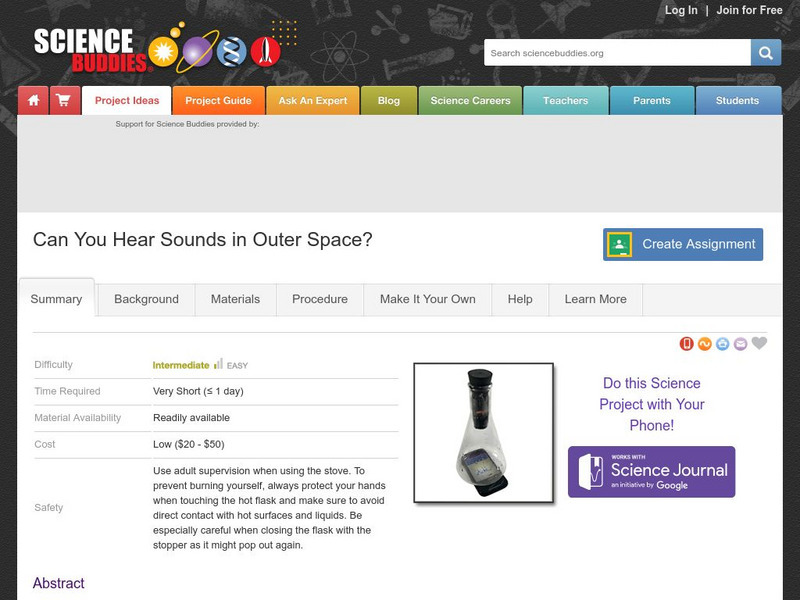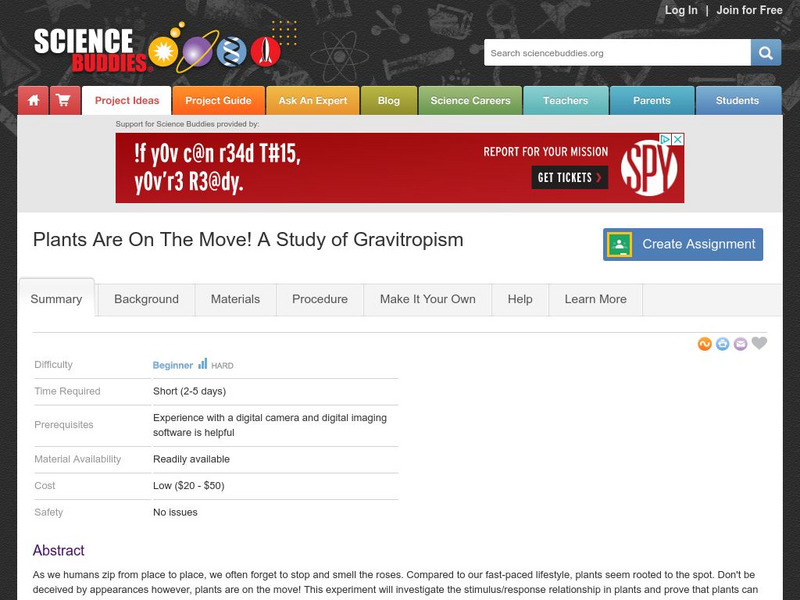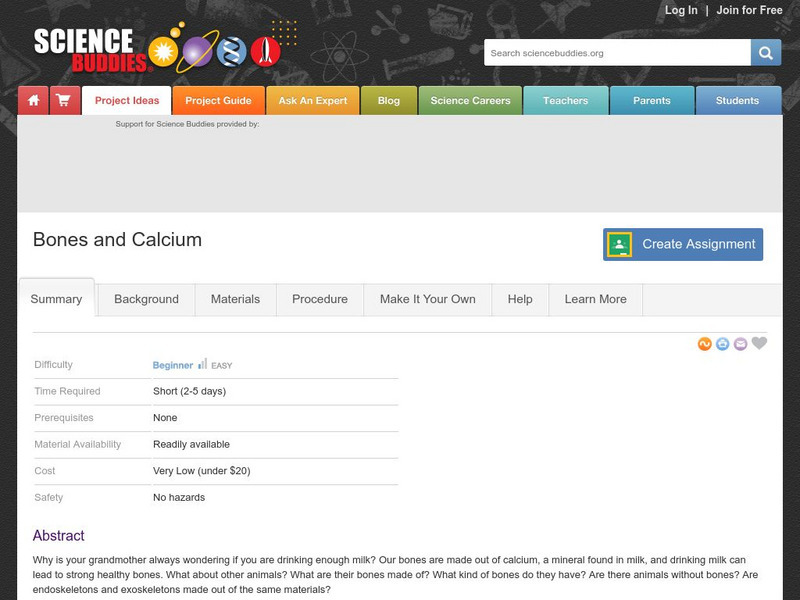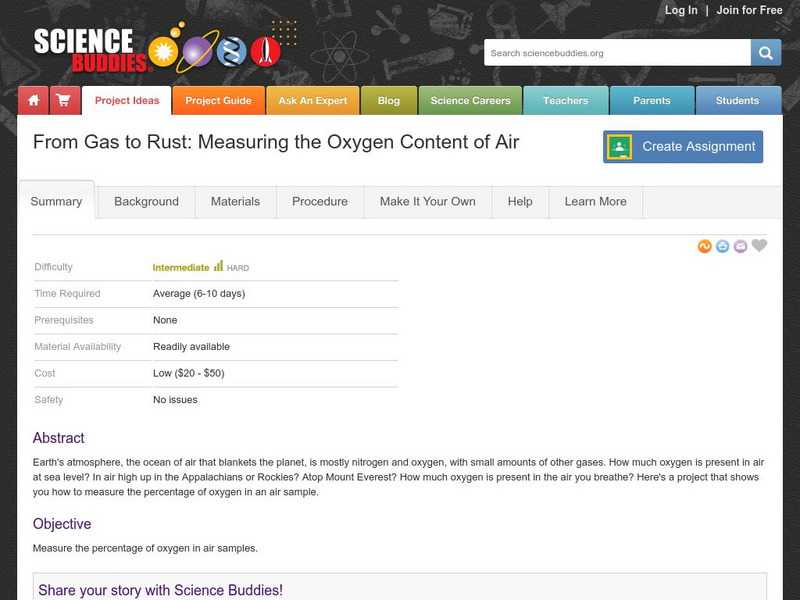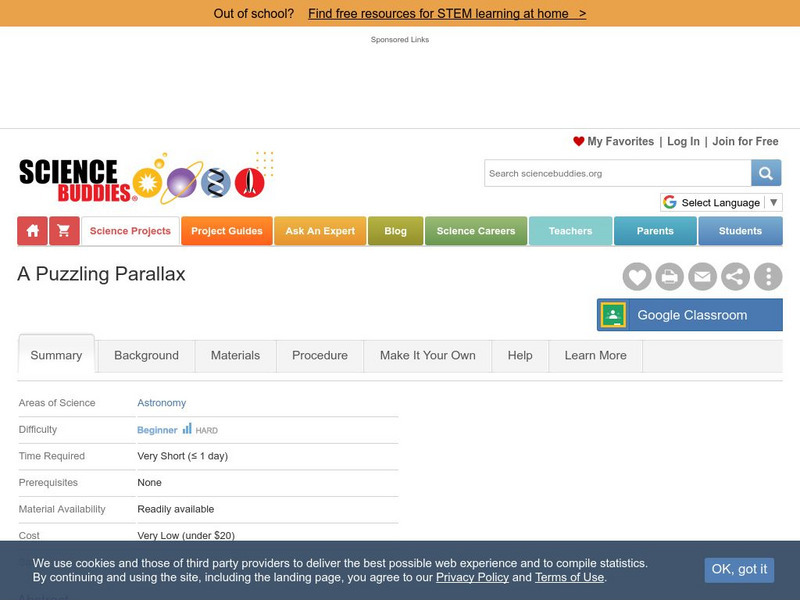Science Buddies
Science Buddies: Slip Sliding Away: Experimenting With Friction
As you headed up the mountain to enjoy your last ski trip, you may have noticed a sign reading: Hazard. Icy Roads Ahead, Put On Your Chains. Putting chains on car tires increases the resistance between the tires and the road allowing the...
Science Buddies
Science Buddies: Balancing the Load: The See Saw as a Simple Machine
Have you ever tried to pull out a nail out of wood with your bare hands? Or have you tried to shove a staple through a stack of papers without a stapler? A hammer's claw, a stapler, a pair of pliers and a shovel are each examples of...
Science Buddies
Science Buddies: What Goes Up, Must Come Down
Standing on a balcony near the top of the 179-foot tall Tower of Pisa, a young scientist dropped two iron balls into the crowd below. The scientist, young Galileo, was not trying to knock his fellow professors on the head, but was trying...
Science Buddies
Science Buddies: Swing Low: Investigate the Motion of a Pendulum
Kids love to ride the swings at the playground. The back-and-forth motion of a swing demonstrates the physics of a pendulum. In this experiment, you will investigate the factors that affect the speed and duration of a pendulum's swing.
Science Buddies
Science Buddies: Outer Space, the Silent Frontier: An Experiment on Sound Waves
In outer space there is utter silence. There are no sounds of traffic jams or thunderstorms or crashing waves. No buzzing bees or babies crying. Just silence. In this experiment, you will discover why empty space is void of sound.
Science Buddies
Science Buddies: Centripetal Force
What keeps you in your seat of a giant loop-de-loop roller coaster? Surprisingly, it is not the seatbelt but the seat. It works because of something called centripetal force and it does much more than make a great roller coaster. In this...
Science Buddies
Science Buddies: Are Laminates Stronger?
If you love to hit the half pipe with your snowboard or skateboard, then you have tested the strength and durability of laminates. Laminates are sandwiches of different materials that are glued together in layers to give strength and...
Science Buddies
Science Buddies: An Aerobic Exercise: Yeast Metabolism and Aeration
This is a straightforward project on glucose metabolism in yeast. You'll grow yeast under aerobic and anaerobic conditions and measure carbon dioxide output to assess metabolic efficiency.
Science Buddies
Science Buddies: Radiant Radish Seeds
We all know that plants need sunlight and water to grow big and tall. But did you know that inside seeds are baby plants, and that the fragile baby plant inside the seed needs to be protected? If you've ever had a sunburn, you also know...
Science Buddies
Science Buddies: Nitrogen Fixing Bacteria and Nitrogen Fertilizers
Plants need nitrogen to build proteins and nucleic acids to grow healthy stems and leaves. Though the Earth's atmosphere is made up of 79% nitrogen, the form of nitrogen found in the atmosphere cannot be used by plants. In this...
Science Buddies
Science Buddies: It's Crowded in Here! A Study of Plant Population Density
Like humans, plants can be negatively affected by overcrowding. Unlike humans, plants cannot get up and move to a new environment or explore how to utilize new resources. This experiment will explore the effects of crowding (population...
Science Buddies
Science Buddies: Gone With the Wind: An Experiment on Seed and Fruit Dispersal
If you have ever made a wish and blown the fluff of a dandelion, you have witnessed how some plants are adapted to spreading their seeds using the wind. The tiny, furry parachute allows the seeds to be picked up by the wind and to be...
Science Buddies
Science Buddies: Plants Are on the Move! A Study of Gravitropism
As we humans zip from place to place, we often forget to stop and smell the roses. Compared to our fast-paced lifestyle, plants seem rooted to the spot. Don't be deceived by appearances however, plants are on the move. This experiment...
Science Buddies
Science Buddies: How Much Worm Is a Worm?
Worms are slimy, wiggly, and gross. But did you know that they have many unique abilities? One of the neatest things that worms can do is regenerate, or re-grow, parts of their body. After a piece of a worm is cut off, it can grow back...
Science Buddies
Science Buddies: Digital Photo Resolution
Do you have a favorite picture? When you have a photo that you treasure, you want it to look as good as possible. Find out how the resolution of a digital photo effects the way it looks when you print it out. How does the quality of the...
Science Buddies
Science Buddies: Estimation and Population Size
Have you ever wanted to take a short cut? How about when doing your math homework? In this experiment you can learn how estimation can save you time doing math calculations. But beware, some estimations are better than others. Can you...
Science Buddies
Science Buddies: Bones and Calcium
Why is your grandmother always wondering if you are drinking enough milk? Our bones are made out of calcium, a mineral found in milk, and drinking milk can lead to strong healthy bones. What about other animals? What are their bones made...
Science Buddies
Science Buddies: Who Has the Biggest Genome?
Humans are complex creatures, but do we have the biggest genome? All living things, from humans to worms to bacteria have genomes. In this experiment you will compare the genome sizes of different organisms to find out who has the...
Science Buddies
Science Buddies: What Is Home Sweet Home to a Bug?
If you had to choose between having your favorite dessert, going to a movie, or spending the night at a friend's house, which would you choose? This project shows you how you can "ask" a sowbug (or pill bug) a similar question in order...
Science Buddies
Science Buddies: A Magnifying Discovery
Have you ever looked through a magnifying lens? Why do things look bigger when you look at them through the magnifying lens? Even though the object appears to get larger, it really stays the same size. Each lens has its own unique power...
Science Buddies
Science Buddies: From Gas to Rust: Measuring the Oxygen Content of Air
Earth's atmosphere, the ocean of air that blankets the planet, is mostly nitrogen and oxygen, with small amounts of other gases. How much oxygen is present in air at sea level? Is air high up in the Appalachians or Rockies? Atop Mount...
Science Buddies
Science Buddies: Measuring Up
Measurements are very important for scientists. It is especially important that the measurements be accurate. Think about how important accuracy is when you want to know if you are taller than a friend of yours, every inch counts. In...
Science Buddies
Science Buddies: A Puzzling Parallax
Did you know that ancient astronomers could measure the distance to other stars? They could also distinguish between stars and planets. How could they do that without modern technology of telescopes? See if you can discover the link...
Science Buddies
Science Buddies: Changing Constellations
Do you like to look up into the night sky? There are so many stars, it can be mind boggling. Some ancient people marked time by the changes in star patterns. We still use changes in constellation patterns to mark astronomical time. This...




